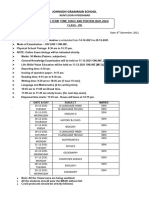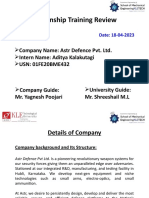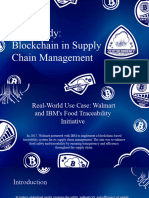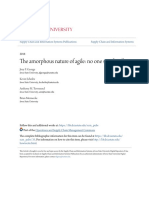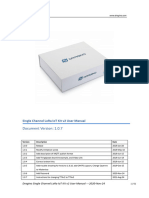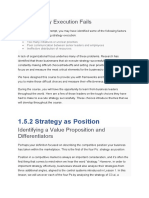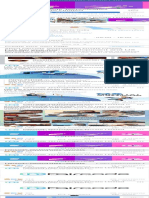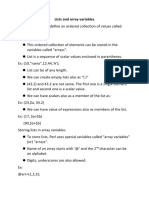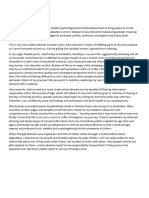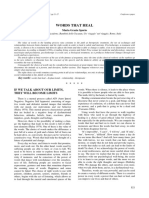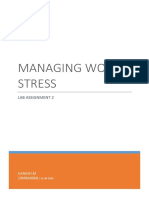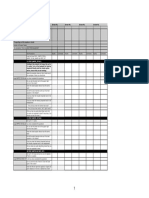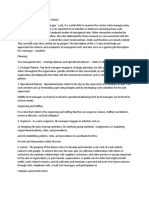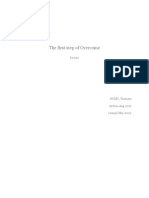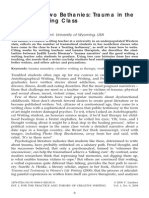Comprehensive Overview of The Words I Never Dared To Say
Uploaded by
Abdul Basit KhanComprehensive Overview of The Words I Never Dared To Say
Uploaded by
Abdul Basit KhanCOMPREHENSIVE OVERVIEW OF "THE WORDS I NEVER DARED TO
SAY" BY ISABELLE MIUMIU
Introduction and Premise
Isabelle Miumiu’s The Words I Never Dared to Say is a dual offering: a deeply
personal memoir and a therapeutic guidebook. Blending vulnerability with practical
wisdom, the book explores the transformative power of writing as a tool for emotional
liberation. Miumiu’s journey from silence to self-expression serves as both a narrative
anchor and a roadmap for readers seeking healing.
Structure and Content
The book unfolds as an intimate odyssey, structured around the author’s own
experiences with trauma, grief, and societal pressures to suppress emotions. Interspersed
with these personal vignettes are insights into therapeutic writing methodologies, backed
by psychological research on expressive writing’s benefits. Practical exercises encourage
readers to confront their own narratives, fostering a dialogue between emotion and
articulation. The text balances introspection with actionable advice, making it accessible
to those new to therapeutic writing.
Thematic Elements
1. Vulnerability and Authenticity: Miumiu challenges societal norms that equate
emotional openness with weakness. Her raw accounts of personal struggles humanize
vulnerability, reframing it as a strength.
2. Healing Through Expression: The book underscores how writing externalizes
pain, transforming overwhelming feelings into manageable narratives. Miumiu references
studies showing journaling’s role in reducing stress and fostering resilience.
3. Cultural Stigma and Empowerment: By sharing her journey, Miumiu advocates
for dismantling taboos around mental health. The act of writing becomes an act of
rebellion against silence, empowering readers to reclaim their voices.
4. Transformational Journeys: The narrative arc—from stifled silence to articulate
empowerment—reflects a universal desire for emotional freedom. Miumiu’s story
mirrors the potential for readers to transmute pain into purpose.
Reflective Analysis
Miumiu’s work resonates in a culture where emotional expression is often
discouraged. By intertwining memoir with therapeutic guidance, she bridges the gap
between personal experience and collective healing. The feather on the cover symbolizes
both the weight of unspoken words and the lightness that comes from letting them go.
The book’s strength lies in its duality: it is both a testament to the author’s courage and a
compassionate invitation to readers to embark on their own journeys.
Audience and Takeaway
Ideal for those navigating grief, trauma, or stifled self-expression, the book also
appeals to mental health advocates and writers. Readers gain validation for their struggles,
tools for articulation, and hope through Miumiu’s example. The exercises, ranging from
free-writing prompts to structured reflections, are designed to meet diverse emotional
needs, making the book a versatile resource.
Significance and Impact
Miumiu contributes meaningfully to conversations on emotional well-being by
advocating for writing as a democratic, accessible tool. Her work highlights the
intersection of art and therapy, emphasizing that healing is both individual and communal.
By sharing her story, she normalizes vulnerability, fostering a culture where emotional
honesty is celebrated rather than silenced.
Conclusion
The Words I Never Dared to Say is a testament to the resilience of the human spirit
and the healing power of words. It invites readers to transform their unspoken burdens
into liberating narratives, offering both solace and agency. In an era where mental health
discourse is evolving, Miumiu’s book stands as a beacon of empathy and empowerment,
proving that the simplest act of writing can be the most profound path to freedom.
How Does the Book Help with Emotional Healing?
The book primarily helps with emotional healing by blending the author’s personal
memoir with therapeutic guidance. It emphasizes the power of vulnerability and
authenticity, encouraging readers to confront and articulate their emotions. The narrative
demonstrates how writing can transform overwhelming feelings into manageable
narratives, fostering resilience and reducing stress. Interspersed practical exercises and
prompts provide tools for readers to engage in self-expression and reflection. It advocates
for emotional openness, normalizing vulnerability as a strength and challenging societal
taboos around mental health. The book’s message of empowerment through writing offers
readers a sense of agency and control over their emotional journeys, ultimately aiding in
their healing process.
Examples of Practical Exercises from the Book
"The Words I Never Dared to Say" by Isabelle Miumiu incorporates various
practical exercises to help readers achieve emotional healing through writing. Below are
some examples of these exercises:
Letter Writing
Rage Letter: Write a letter expressing all the anger and resentment you feel
toward a specific person or situation. Pour out everything you wish you could say but
haven’t, without holding back or censoring yourself. Allow yourself to fully express the
anger, even if it includes shocking or extreme content. After completing the letter, you
can choose to destroy it or keep it as a record of your emotions. This exercise helps release
pent-up anger and prevents it from causing harm to yourself or others.
Sadness Letter: Write a letter about the sadness and pain you are experiencing.
Begin with “I am sad because...” and write from the perspective of sadness. Describe
what feels lost, hurt, damaged, tender, aching, or vulnerable. Let yourself cry if tears come
and breathe through them. This exercise allows you to acknowledge and process your
sadness, helping to alleviate its weight.
Gratitude Letter: After releasing emotions through rage and sadness letters, write
a gratitude letter focusing on the positive aspects and lessons learned from the experience
or relationship. Express gratitude for what the person or situation has taught you and how
it has contributed to your growth and healing. This shift in perspective can help you find
meaning and value in difficult experiences.
Free Writing
Stream-of-Consciousness Writing: Set a timer for 10-15 minutes and write
continuously without stopping or overthinking. Write down whatever comes to mind,
whether it’s related to a specific emotion, event, or seemingly random thoughts. This
exercise helps bypass the inner critic and allows emotions and thoughts to flow freely
onto the page, uncovering subconscious feelings and concerns.
Writing About a Specific Theme: Choose a theme such as “abandonment,”
“guilt,” or “self-love” and write freely about it. Explore your thoughts, feelings, and
experiences related to the theme. This can deepen your understanding of specific
emotional issues and provide insights for healing.
Narrative Reconstruction
Rewriting the Story: Select a past event that caused you emotional pain or trauma
and rewrite the narrative. Imagine how you would like the event to have unfolded or how
you hope to resolve it. This exercise empowers you to reclaim agency over your story and
reduces the impact of negative past experiences on your present life.
Creating a New Future Story: Visualize your ideal future and write about it in
detail. Describe the emotions, relationships, and achievements you hope to experience.
This exercise helps shift your focus from past wounds to future possibilities, fostering
hope and motivation.
Dialogue Writing
Inner Child Dialogue: Write a dialogue between your adult self and your inner
child. Allow your inner child to express unmet needs, fears, and emotions, and respond
with compassion and understanding from your adult perspective. This exercise helps heal
inner wounds and fosters self-compassion.
Dialogue with a Significant Other: Write an imagined dialogue between yourself
and someone who has significantly impacted your emotions, such as a parent, partner, or
friend. Express your true feelings and listen to their responses. This can help resolve
conflicts, gain new perspectives, and facilitate emotional closure.
Poetic and Creative Writing
Poetry Writing: Use poetry to express emotions artistically. The rhythm, rhyme,
and metaphorical language of poetry can capture complex emotions in a unique way,
providing a sense of catharsis and beauty.
Metaphor and Symbolism Writing: Write about your emotions using metaphors
and symbols. For example, describe anxiety as a stormy sea or loneliness as a deserted
island. This exercise helps you view emotions from a different angle and enhances self-
awareness.
Journaling
Daily Emotional Journaling: Set aside time each day to write about your
emotions and experiences. Record events that triggered specific emotions, how you felt
physically and mentally, and your thoughts about the situation. Over time, this can help
you identify emotional patterns and triggers, enabling better emotional management.
Gratitude Journaling: Regularly write about things you are grateful for. They
can be major events or small moments of joy and warmth. Gratitude journaling shifts your
focus to positive aspects of life, improving mental well-being and resilience.
When engaging in these writing exercises, it is essential to prioritize self-compassion
and avoid self-judgment. Remember that the purpose of writing is to express and heal,
not to create a perfect piece of writing. Additionally, if any exercise becomes
overwhelming, pause and take a break. You can also combine these exercises with other
therapeutic practices like meditation and counseling for better emotional healing
outcomes.
How Does Therapeutic Writing Impact Mental Health?
Therapeutic writing, also known as expressive writing or written disclosure therapy,
refers to the process of writing about personal traumatic, stressful, or emotional
experiences. It is a simple yet powerful tool that can positively impact mental health.
Emotional Catharsis
Writing provides an outlet for intense emotions that may otherwise be difficult to
express verbally. When individuals face traumatic or stressful events, they often suppress
their emotions, which can lead to emotional buildup and psychological distress. Through
therapeutic writing, people can freely express their innermost feelings, vent negative
emotions such as sadness, anger, and fear, and achieve emotional release and catharsis.
This helps alleviate psychological pressure and reduce the risk of emotional disorders.
For example, in a study by Pennebaker, participants who wrote about traumatic life events
for 15-20 minutes a day over four consecutive days experienced a short-term increase in
distress and negative mood, but long-term benefits included improved immune function,
lower blood pressure, better mood, enhanced psychological well-being, reduced
depressive symptoms, and fewer post-traumatic intrusion and avoidance symptoms
(Pennebaker & Beall, 1986).
Enhanced Cognitive Processing
Therapeutic writing allows individuals to reflect on and process their experiences,
helping them gain deeper insights into their emotions and thoughts. When writing,
individuals need to organize scattered memories and feelings into a coherent narrative.
This process facilitates cognitive restructuring, enabling them to view traumatic events
from a more rational and objective perspective, reducing the emotional impact of negative
experiences, and fostering a more adaptive understanding of themselves, the world, and
others. Additionally, writing helps individuals identify patterns in their thoughts and
behaviors, such as maladaptive thinking or rumination, which can contribute to mental
health issues like anxiety and depression. By recognizing these patterns, individuals can
develop strategies to address them, thereby improving their mental health (Smyth, 1998).
Increased Self-Awareness
Writing requires individuals to focus inward and confront their true feelings and
thoughts. This process enhances self-awareness, helping individuals better understand
their emotional needs, values, and life goals. It enables them to recognize the root causes
of their psychological distress and fosters self-acceptance and self-compassion.
Furthermore, therapeutic writing provides individuals with a space for self-reflection and
exploration, allowing them to discover their inner strengths and resilience, boost self-
confidence, and enhance their ability to cope with life's challenges.
Stress Reduction
Expressive writing can help individuals manage stress by reducing the physiological
and psychological effects of stress. When people write about stressful events, they can
process their emotions and thoughts related to the stressors, which helps lower cortisol
levels, decrease blood pressure, and improve immune function. Studies have shown that
writing about stressful experiences can reduce stress-related visits to healthcare providers
and improve physical and mental health outcomes.
Improved Mood and Psychological Well-Being
Therapeutic writing positively impacts mood and psychological well-being. It helps
individuals shift their focus from negative emotions to positive aspects of life. For
instance, gratitude journaling encourages individuals to reflect on and express gratitude
for positive experiences and relationships, fostering a more optimistic mindset and
enhancing happiness and life satisfaction. Research indicates that expressive writing can
lead to improved moods, reduced depressive symptoms, and enhanced overall
psychological well-being (Frattaroli, 2006).
Strengthened Coping Abilities
Through therapeutic writing, individuals can develop more effective coping
strategies for dealing with life's difficulties. Writing about challenging experiences allows
them to explore various ways to address problems and find solutions. It also helps them
build emotional resilience, enabling them to better adapt to stress and adversity. Over
time, this enhances their ability to cope with future challenges.
Enhanced Self-Expression and Communication Skills
Therapeutic writing provides individuals with a platform to practice self-expression
and improve their communication skills. By articulating their thoughts and feelings in
writing, individuals can learn to express themselves more clearly and effectively. This, in
turn, improves their communication with others, deepens interpersonal relationships, and
reduces misunderstandings and conflicts. Stronger communication skills also help
individuals seek social support when needed, further promoting mental health.
Creating a Personal Narrative
Therapeutic writing helps individuals construct a coherent and meaningful personal
narrative. Through writing, they can piece together fragmented memories and experiences
into a cohesive story, providing a sense of order and meaning to their lives. This narrative
creation helps individuals find purpose and significance in their experiences, fostering a
sense of identity and belonging. It also enables them to derive lessons from past
experiences, guiding their future actions and decisions.
Potential Limitations and Considerations
While therapeutic writing offers numerous benefits for mental health, it may not be
suitable for everyone. For instance, individuals with severe mental illnesses such as
psychosis or severe depression might find the emotional intensity of writing
overwhelming. In such cases, it is advisable to consult a mental health professional before
engaging in therapeutic writing. Additionally, therapeutic writing is not a substitute for
traditional psychotherapy. It works best as a complementary tool to professional
psychological treatment. For complex mental health issues, individuals should seek
assistance from qualified therapists to ensure effective treatment.
In summary, therapeutic writing positively impacts mental health by providing
emotional catharsis, enhancing cognitive processing, increasing self-awareness, reducing
stress, improving mood and psychological well-being, strengthening coping abilities,
refining self-expression and communication skills, and helping individuals create a
personal narrative. It serves as a simple yet effective tool for mental health maintenance
and improvement. However, its effectiveness may vary depending on individual
circumstances and the nature of the issues being addressed. When using therapeutic
writing, it is important to consider one's own situation and combine it with other
therapeutic methods to achieve optimal mental health outcomes.
References
Miumiu, I. (2020). The Words I Never Dared to Say: A journey toward emotional
freedom and healing through therapeutic writing. Independently published.
https://www.ebay.com/itm/365628202204
Pennebaker, J. W., & Beall, S. K. (1986). Confronting a traumatic event: Toward an
understanding of inhibition and disease. Journal of Abnormal Psychology, 95(3),
274–281. https://doi.org/10.1037/0021-843x.95.3.274
Smyth, J. M. (1998). Written emotional expression: Effect sizes, outcome types, and
moderating variables. Journal of Consulting and Clinical Psychology, 66(1), 174–
184. https://doi.org/10.1037/0022-006x.66.1.174
Frattaroli, J. (2006). Experimental disclosure and its moderators: A meta-analysis.
Psychological Bulletin, 132(6), 823–865. https://doi.org/10.1037/0033-
2909.132.6.823
Studied by Khan and Ali,
Shaanxi Normal University,
2025












